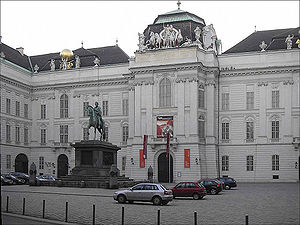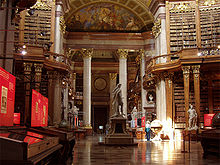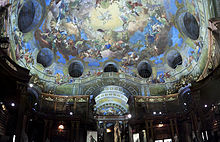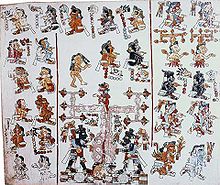- Austrian National Library
-
Österreichische Nationalbibliothek English Austrian National Library 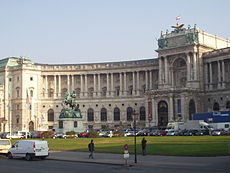
The main entrance on Heldenplatz Country Austria Established 18th century Location Vienna Coordinates 48°12′22″N 16°21′59″E / 48.20611°N 16.36639°ECoordinates: 48°12′22″N 16°21′59″E / 48.20611°N 16.36639°E Collection Size 7.4M Website http://www.onb.ac.at/ev/index.php Phone number +43 1 534 10 The Austrian National Library (German: Österreichische Nationalbibliothek, abbreviated "ÖNB" and formerly Hofbibliothek ), is the largest library in Austria, with 7.4 million items in its collections. It is located in the Hofburg Palace in Vienna; since 2005 some of the collections are located in the baroque Palais Mollard-Clary. Founded by the Habsburgs, the library was originally located in the current Prunksaal building and called the Hofbibliothek, changing to its current name after 1920.[1]
The collections consist of: papyri, manuscripts, ancient and rare books, maps, globes, music, portraits, graphics, photographs, autographs and posters as well as works in and on Esperanto and other artificial languages are stored in the various collections and are available for scientific research.
Contents
History
The Austrian National Library has a long history spanning centuries, from the Middle Ages, through the Austrian Empire and Austro-Hungarian Empire, and into the 21st century, with online access via the Internet web.
Middle Ages and early modern times
The Austrian National Library has its origin in the imperial library of the Middle Ages. During the Medieval period, the Austrian DukeAlbrecht III (1349-1395) shifted the books of the Viennese vaults into a library. Albrecht also organized important works from Latin to be translated into German.[1] In the Hofburg, the treasure of Archduke Albrecht III had been kept in sacristies inside the south tower of the imperial chapel.[1] The Archduke was a connoisseur of art: he supported the University of Vienna, and he founded a royal work shop for illustrating manuscripts. The oldest book on record at the Austrian National Library, the 1368 golden Holy Gospels, was owned by Albrecht III: in 1368, Johannes of Troppau, priest at Landskron and canon in Brno, transcribed the four Gospels of the Bible in gold letters with detailed illustrations in the school of Burgundian book art.[1] On scenes depicting the lives of the four Evangelists, four coats of arms show the House of Austria, Tirol, Styria, and Carinthia, the lands which Archduke Albrecht III had ruled at the time.[1]
Frederick III, Holy Roman Emperor (1415-1493), had the goal of summarizing the art treasures among the Habsburg possessions. Among other things, he brought some valuable books into the Viennese new city, among them the Prager Wenzelsbibel and the document of the golden bull.
Holy Roman Emperor Maximilian I (1459-1519), through his marriage with Maria von Burgund, came into the possession of important books from Burgundy and north France, and brought these to Vienna Neustadt. With a value at that time estimated at 100,000 guldens, these books represented about an eighth of Maria's dowry. Also Maximilian's second wife, Bianca Maria Sforza, brought into the marriage as dowry, among other things, books from Italian workshops.
The books of the Court Library, at that time, were kept partially in Wiener Neustadt, partially in Vienna, and partially in Innsbruck. After the death of Maximilian, books came into the Innsbruck castle. Besides the valuable books from the public treasury, during the 16th century, the Bibliotheca Regia, which collected and categorized scientific works, developed in Vienna. Besides books, that library also contained globes and atlases. The library was increased, in the course of the time, by donations of the personal libraries of individual scholars.
As the first librarian of the Imperial Library, Hugo Blotius was appointed in 1575 by Maximilian II. His most important task was drawing up the inventory of the library, which had grown to approximately 9,000 books. As a consequence, new works were added systematically, and other libraries were incorporated.
For the first time on 26 August 1624, the delivery was regulated by obligation copies to the Imperial Library, by order of Ferdinand II. The Imperial Library also grew by purchases. Particularly, the library of Philipp Eduard Fugger led to a major expansion of the Imperial Library. From the Fugger library, the Austrian National Library has about 17,000 sheets of one of the first periodic printing elements, the Fugger newspapers.
Baroque
In 1722, Emperor Karl VI authorized the construction of a building for the Imperial Library in the Hofburg, after the plans of Leopold I. The library was begun by Johann Bernhard Fischer von Erlach, as the current Prunksaal, and accommodated the exhibits of the Imperial Library in the 19th century.
The most valuable addition, at that time, was the book collection of Prinz Eugen von Savoyen (Prince Eugene of Savoy), whose 15,000 volumes cover valuable books from the French and Italian area. The hall of the Imperial Library has become the Prunksaal of the Austrian National Library, in which about 200,000 books are stored.
During the reorganization, for the first time, loud criticism moved to the fact that the Court Library served mainly the representation rather than knowledge transfer. Doctor Gerard van Swieten, physician to Maria Theresia, and his son Gottfried van Swieten supplemented the collection with numerous scientific works. Thus the Court Library became important also for scientific work. A special success was an introduction from Gottfried van Swieten, the card index. Thus the inventory index of the library could be kept current.
Austrian Empire
After the Holy Roman Empire of the German nation, the Court Library was again re-organized. Under custodian Paul Strattmann, the Court Library received a program for the first time which described its order; the imperial Court Library gained a three-way viewpoint:
- it was the library for the formed Classe of the capital, requiring instruction;
- it was the national library of the Austrian Kaiserthum (kingdom), where natives and foreigners expected to find literary rareness; and, finally,
- it was the library of the Hofburg, from which it has its designation. Thus typographic splendour is connected.
The collection politics of the Imperial Library separated at the beginning the 19th century appreciably due to the requirements of the representation and its attention to scientific works. The multinational condition of the Austrian Empire brought with itself that, in the Imperial Library, not only German-language books were collected, but also books of the slavic and Hungarian linguistic area. Substantial parts of the Hungarian collection moved to Budapest, however, after reconciliation with Hungary. During the March revolution of 1848, the Imperial Library was in extreme danger, when after the bombardment of Vienna, the Hofburg, in which the Imperial Library was located, burned.
An important addition to the Imperial Library is the papyrus collection, which goes back to the acquisitions of the Viennese of antique dealer Theodor count.
First Republic and German Reich
After proclaiming the Republic of Austria, the Hofburg library, Hofbibliothek, was renamed in 1920 as the Austrian National Library.[1] The collection politics of intermediate wartime concentrated on "the national literature of those German trunks, which came now under foreign-national rule." The director at that time of the library was Josef Donabaum. During the Nazi period (NS-zeit), under the line of the general manager, at that time, Paul Heigl, hundred of thousands of writings, were accommodated here or the library served for majority the worthless, but seized works as transit camps into German libraries.
Second Republic
After 1945, renamed again into the Austrian National Library, small parts were returned again, the majority remained however in the collections. The attention of the collection activity was directed again in small steps toward central and Eastern Europe.
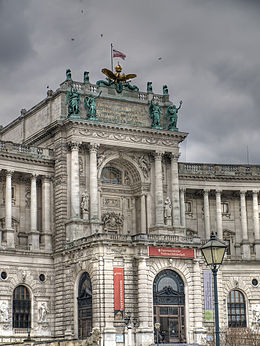 Neue Burg, Entrance to the National Library on Heldenplatz
Neue Burg, Entrance to the National Library on Heldenplatz
In 1966, large parts of the collections were moved from the building at the Josefsplatz to the premises of the new castle at the Heldenplatz, whereby there also new reading halls were furnished. In 1992 became, due to the rising space requirement, which opens low memory below Heldenplatz, where on four levels approximately 4 million works. Also wider ranges than reading halls were furnished at the same time, so that today three levels are at the disposal of visitors (two floors of the main reading hall and the magazine reading hall).
The Austrian National Library for a long time maintained loyalty to the card-catalog index. Since 1995, the library has been electronically scanable, since 1998 also on-line to the Internet. To restitution only at the year 2001 with it begun still available "arisierten" values, where still owners or their inheriting were discoverable. It concerned thereby nearly 25,000 works.
ÖNB as legally liable, scientific institute
On January 1, 2002, the Austrian National Library gained the full legal capacity to dismiss. This brought the full control to the mechanism in budget and personnel questions. The National Library keeps placed thereby from the federation a certain annual budget to the order; additional funds must be raised by sponsorships, reproduction services, and the loaning from the premises. Organizationally, the National Library uses a central management and is in three head departments (personnel and accounting, inventory structure and treatment, as well as use and information), plus the individual collections arranged.
In 2006, Dr. Johanna Rachinger managed the National Library. It is responsible to a Kuratorium, to which quarterly reports must be sent.
Prunksaal (Hofbibliothek)
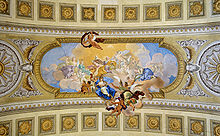 Prunksaal: allegory of peace and heaven. Ceiling painting made by Daniel Gran (1694-1757) finished in 1730.
Prunksaal: allegory of peace and heaven. Ceiling painting made by Daniel Gran (1694-1757) finished in 1730.
 Prunksaal: allegory of war and law. Ceiling painting made by Daniel Gran (1694-1757) finished in 1730.
Prunksaal: allegory of war and law. Ceiling painting made by Daniel Gran (1694-1757) finished in 1730.
The Prunksaal (English: splendor hall) was the former building of the Imperial Library, called the "Hofbibliothek" until 1918.
It was built particularly for the Court Library, and the books in the Minoritenkloster were stored (see: Minoritenkirche). The building was begun in 1721 by Johann Bernhard Fischer von Erlach and finished after his death in 1723 by his son Joseph Emanuel.
The sculptures on the building come from Lorenzo Mattielli. The Prunksaal is divided, after the original list of the books, into a "war" and a "peace" side, which is reflected also in the wall frescoes, from Daniel Gran. The fresco in the central dome represents a kind Apotheose Karl VI, whose picture is held by Hercules and Apollo. Around the picture of the emperor all kinds of allegorical figures are met in a complicated theme, which are to symbolize the virtues of the Habsburgs and the wealth of their countries.
In the time of Maria Theresia, cracks appeared in the dome, so Court Architect Nikolaus Pacassi strengthened the dome with an iron ring. The memorial fresco of Gran (in which the trace of a tear can be seen) was restored by Franz Anton Maulbertsch.
At the same time, the building wings were developed, which connect the Prunksaal with the Court Castle and the St. Augustine's Church and form with it Joseph Square (Josefsplatz). Also in the Prunksaal are located emperor statues, created by the sculptors Peter Strudel and Paul Strudel (with Karl VI in the center), and four globes of Vincenzo Coronelli.
The collections
One of the major tasks of the Austrian National Library is the collection and archiving of all publications appearing in Austria (including electronic media). Depending on the law for the medium, four copies, and by other printing elements, two obligation copies each, must be delivered to the National Library by periodic printing elements appearing in Austria.
In addition, the library collects all works of Austrian authors appearing abroad, as well as such works which concern Austrians or the Austrian spirit and culture. Further publications from the foreign country are taken up with emphasis on the range of the Geisteswissenschaften. Tasks and services of the national library cover the development of the existence and their supply in the form of local-loan, remote-loan, and search services as well as Auskunfts, information and reproduction services.
The legally given general order for education is obeyed also by co-operation with universities, schools and adult education mechanisms.
Altogether, the National Library has more than seven million objects, of which approximately three million are printed.
Manuscripts and Rare Books
Dating from the 4th century to the present day, this collection includes antique, medieval and modern manuscripts from almost every literate culture. Notable items in the collection include the Vienna Dioscurides, which was inscribed on UNESCO's Memory of the World Programme Register in 1997 in recognition of its world significance and outstanding universal value.[2]
Map Collection and Globe Museum
See also: Map collection and Globe MuseumThe map collection includes maps back to the 16th century and it has existed since 1905. After the First World War, the collection of the Habsburgs was taken over, designated as the Habsburg "Family Estate Library" (Familien-Fideikommiss-Bibliothek).
The map collection includes the Globe Museum which has over 380 globes. It is the world's only public globe museum, and has been in existence since 1956. Some of its globes date back to the 16th century. The principal part of the Globe Museum's inventory consists of globes which existed before 1850. There is also technical literature in the collection, plus similar instruments, such as armillary spheres.
The map collection also includes the 17th century Atlas Blaeu-Van der Hem, a 50-volume set that consists of more than 2,400 maps, prints, and drawings and it was inscribed on UNESCO's Memory of the World Programme Register in 2003.[3]
Papyrus Collection and Papyrus Museum
During the 19th century, the papyrus collection became an important part of the Austrian National Library. The collection goes back to a private collection of Austrian Archduke Rainer, who gave the collection to the Austrian Emperor Franz Joseph I on 18 August 1899. The Papyrus Collection contains about 180,000 objects from the period between that of 15th Century before Christ (BCE) and the 16th Century (CE). Besides papyri the collection includes papers, records on clay tablets, inscribed wood and wax trays, stone tablets, leathers, textiles and bones, as well as gold, silver and bronze articles with inscriptions. The Papyrus Collection (Collection Erzherzog Rainer) of the National Library is the largest such collection worldwide, and was inscribed on UNESCO's Memory of the World Programme Register in 2001.[4]
Music
In the music collection, since 1826, are numerous scores and first-printings of works of well-known composers, such as Anton Bruckner or Richard Strauss. Also numerous recordings such as records or CDs are kept. Among the music collection are also many handwritten notes and thoughts of composers.
Incunabula, old and precious prints
The collection of incunabula, old and valuable printings (SIAWD) is one of the five largest collections of historical block printing of the world. As an independent collection, it has existed since 1995 and ranks thereby among the youngest of the National Library. The collection covers approximately 8,000 incunabula (fourth largest in existence worldwide), block printing from 1501 to including 1850 (e.g. the Fugger newspapers), and bibliophile as well as rare and valuable printings without temporal restriction. The SIAWD collection has been supplemented with Chinese and Japanese printing.
Austrian National Library collections
- Department of Broadsheets, Posters and Ex Libris: 330,000 objects (broadsheets, posters and Ex Libris)
- Department of Manuscripts, Autographs and Closed Collections: From the 4th century to the present day: late antique, medieval and modern manuscripts from almost every literate culture.
- Department of Music: Austria's music archives, and great collection of autographs, it is also one of the largest libraries in the world.
- Austrian Literary Archives
- Picture Archive
- Department of Incunabula, Old and Precious Books:
- incunabula (books printed before 1500),
- printed works from the period 1501-1850 and
- printed bibliophile rarissima of no specific period.
- Archives of the Austrian Folk Song Institute[5]
- Austrian National Library Museums
- State Hall[6]
- Globe Museum: 380 globes and scientific instruments including terrestrial and celestial globes made before 1850[7]
- Papyrus Museum[8]:
- Papyri 137,864
- Archaeological documents (without papyri) 50,769
- Museum objects 5
- Books and serials 14,049
- Microforms 555
- Audiovisual materials 2,292
- Picture documents 16,944
- Department of Planned Languages and Esperanto Museum[7]
See also
- Codex Vindobonensis B 11093
- Codex Vindobonensis Philos. 75
- Codex Vindobonensis Philos. 157
- Codex Vindobonensis Mexicanus I
- Codex Vindobonensis Lat. 502
- Fayyum Fragment (P. Vienna G. 2325)
Notes
- ^ a b c d e f "NB online – The National Library – History" (overview), Österreichische Nationalbibliothek, 2006, ONB.ac.at webpage: ONB-Lib-History.
- ^ Vienna Dioscurides
- ^ The Atlas Blaeu-Van der Hem of the Austrian National Library Memory of the World
- ^ "Papyrus Erzherzog Rainer". UNESCO Memory of the World Programme. 2005-05-16. http://portal.unesco.org/ci/en/ev.php-URL_ID=21314&URL_DO=DO_TOPIC&URL_SECTION=201.html. Retrieved 2009-12-11.
- ^ Österreichisches VolksLiedWerk
- ^ Virtueller Prunksaal
- ^ a b Österreichische Nationalbibliothek
- ^ Department of Papyri – Österreichische Nationalbibliothek
- This article incorporates information from the revision as of 2006-11-17 of the equivalent article on the German Wikipedia.
References
- Ackerl, Isabella [Red.]: Die Österreichische Nationalbibliothek (English: Austrian National Library), Vienna, 1995.
- Höfler, Ida Olga: Portrait-Sammlung und Bildarchiv der Österreichischen Nationalbibliothek ehem. Familien-Fideikommiß-Bibliothek (English: Portrait-collection and image-archive of the Austrian National Library...), Vienna, 1994.
- Hunger, Herbert: Die Papyrussammlung der Österreichischen Nationalbibliothek (English: The Papyrus-collection of the Austrian National Library), Ausstellungskatalog, Vienna, 1962.
- Jobst-Rieder, Marianne: Filmplakate der Österreichischen Nationalbibliothek (1910 – 1955) (English: Films of the Austrian National Library 1910-1955), Vienna, 1998.
External links
- Österreichische Nationalbibliothek – Homepage in English
- Österreichischer Bibliothekenverbund – catalogues of the library collaboration.
- aleph.onb.ac.at/ – Online-Katalog of the ÖNB library.
- bibliographie.onb.ac.at/biblio – Online bibliography of the ÖNB library.
- anno.onb.ac.at – Digital publications.
- Geraubte Bücher – Role of the National Library during the NS-Zeit period.
National libraries of Europe Sovereign
states- Albania
- Andorra
- Armenia
- Austria
- Azerbaijan
- Belarus
- Belgium
- Bosnia and Herzegovina
- Bulgaria
- Croatia
- Cyprus
- Czech Republic
- Denmark
- Estonia
- Finland
- France
- Georgia
- Germany
- Greece
- Hungary
- Iceland
- Ireland
- Italy
- Kazakhstan
- Latvia
- Liechtenstein
- Lithuania
- Luxembourg
- Macedonia
- Malta
- Moldova
- Monaco
- Montenegro
- Netherlands
- Norway
- Poland
- Portugal
- Romania
- Russia
- San Marino
- Serbia
- Slovakia
- Slovenia
- Spain
- Sweden
- Switzerland
- Turkey
- Ukraine
- United Kingdom
- (England
- Northern Ireland
- Scotland
- Wales)
States with limited
recognition- Abkhazia
- Kosovo
- Nagorno-Karabakh
- Northern Cyprus
- South Ossetia
- Transnistria
Dependencies
and other territories- Åland
- Faroe Islands
- Gibraltar
- Guernsey
- Jan Mayen
- Jersey
- Isle of Man
- Svalbard
Other entities Categories:- Libraries in Austria
- National libraries
- Buildings and structures in Vienna
- Innere Stadt
- Manuscripts of the Austrian National Library
Wikimedia Foundation. 2010.

